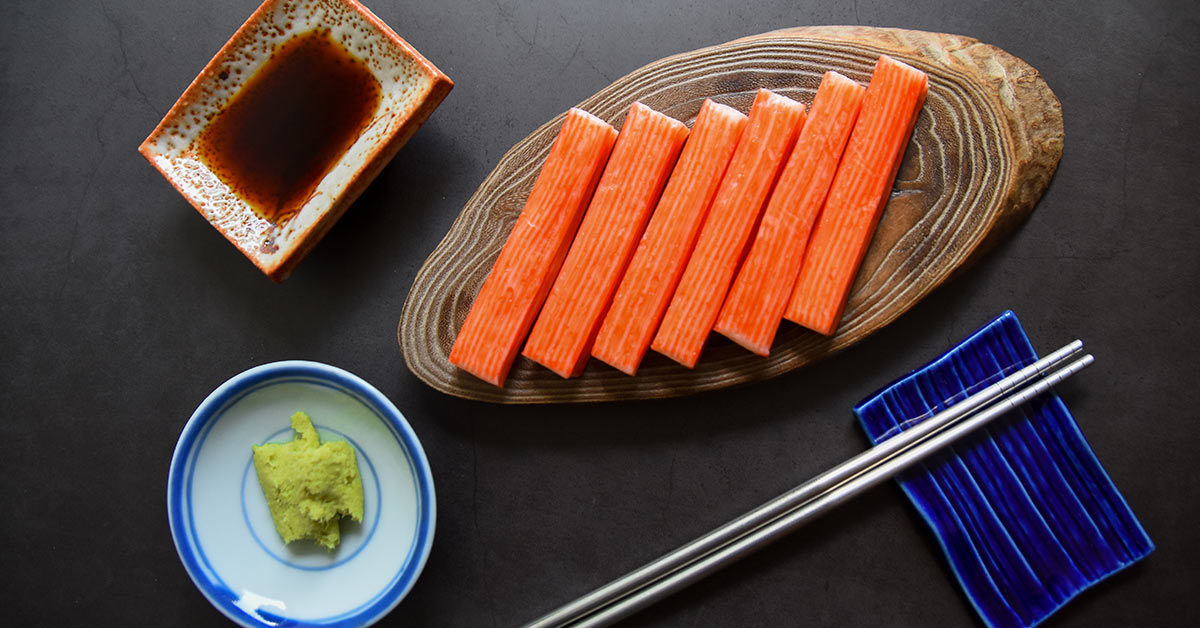When you go out for sushi, do you order crab sticks? Or at least, do you order rolls that have crab sticks in them? Well, in case you didn’t know, unless you’re at a pretty pricey place, those crab sticks aren’t real crab. That’s right: It’s imitation crab. Have you ever stopped to think about what that might actually be made of? Read on to find out.
Crab Sticks: The Hotdog Of The Sea
We’ll get the first thing off the table: Imitation crab sticks are made with real fish, they’re just not made out of crab. In fact, there’s not any real crab in them at all. Apparently, these little rolled-up sticks of crab-flavored goodness are sometimes even referred to as “the hotdog of the sea”.
Crab sticks are made from something called surimi. This is a paste made from real fish, usually a white fish such as pollock. The fish flesh is deboned and washed to remove fat and any other unwanted particles. It is then minced into a paste. Producers then mix that paste with other ingredients, such as crab extract, to give it both color and flavor. (1)
Besides surimi, which is the primary ingredient, crab sticks also include (2):
- Water
- Starch (potato, wheat, corn, or tapioca)
- Protein (egg white protein is the most common, may also include soy)
- Sugar and sorbitol
- Vegetable oil
- Salt (aka sodium chloride)
- Preservatives and other additives
Common additives and preservatives include (3):
- Gums (carrageenan and xanthan)
- Red colorants (Carmine, beet juice, paprika, or lycopene from tomatoes)
- Glutamates (MSG primarily)
- Other flavorings (may include crab extract or artificial crab flavorings)
- Preservatives: Sodium benzoate and other phosphate-based additives
Producers then heat the mixture and press it into whichever shape they want it in. They are then vacuum sealed and pasteurized to kill unwanted bacteria.
Read: What Really Happens When A House Fly Lands On Your Food
The Pros and Cons
On the positive side, imitation crab meat is significantly less costly for restaurants, which also means less cost for you when going out of all-you-can-eat sushi. Its preparation also means it is a ready-to-go food item for quick meals and snacks. There also are healthier versions of fake crab, just as there are healthier hot dog options.
Of course, there are cons:
First of all, fake crab meat, though similar in calories to the real stuff, also contains almost no nutritional value. Meanwhile, real crab meat boasts an impressive nutrient profile, including a much higher protein and omega-3 content.
Second, its environmental impact. Many of the fish that are used for imitation crab sticks are heavily overfished. They are also often caught in a way that threatens the other wildlife. Its production not only uses a lot of water, but it also creates a lot of wastewater which then must be treated so it doesn’t contaminate oceans and other bodies of water.
Finally, due to differences in labeling laws between countries, they can also be mislabeled and even not mention that they contain real fish. Considering that fish is one of the top food allergens, this can be dangerous to people’s health. They also may include other allergens such as wheat or eggs. Mislabeling is also problematic when presented with toxin-based seafood illnesses. (4)
Should You Eat Imitation Crab?
The answer to this is the same for any processed food product. As long as you don’t have any severe food allergies, go for it – just don’t do it all the time. Just as dietitians recommend that hot dogs only represent an occasional part of your diet, so should crab sticks. If you’re going out for sushi frequently, maybe stick to the sashimi and rolls made of fresh fish and vegetables rather than crab meat. If you really love the crab sticks, keep them for special occasion sushi dates only.
Keep Reading: 14 Fish You Could Consider Never Eating
Sources
- “Alternatives for Efficient and Sustainable Production of Surimi: A Review.” IFT. A.M. Martín-Sánchez, et al. September 16, 2009.
- “CPG Sec. 540.700 Processed and/or Blended Seafood Products.” FDA. November 2008.
- “Surimi: something fishy.” PubMed. J J Musmand, et al. September 1996.
- “Advances in the analysis of complex food matrices: Species identification in surimi-based products using Next Generation Sequencing technologies.” PubMed. Alice Giusti, et al. October 2017.

